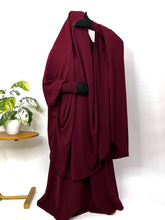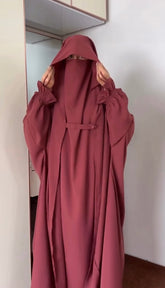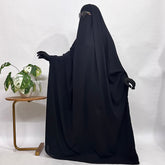The Evolving Threads: New Trends in India's Islamic Clothing Market
India's Islamic clothing market is undergoing a significant transformation. Once characterized by purely functional designs, this market now showcases a dynamic interplay of modesty, elegance, and modern trends, serving to diverse preferences across age groups and occasions.
Generational Preferences in Islamic Clothing Marketing in India
The Islamic clothing market in India is increasingly segmented by generational preferences, with Gen Z and Millennials playing a pivotal role in shaping new trends.
Gen Z (Born 1997-2012)
Gen Z, making up a significant portion of India's population, approaches fashion with a desire for authenticity and resonance beyond mere representation. They are digitally native and highly influenced by social media, which shapes their style choices and shopping habits. For Gen Z, Islamic clothing is not just about adherence to religious principles but also a means of expressing personal identity and embracing global trends.
- Sustainable and ethical options: Reflecting a global trend, Gen Z is more inclined towards brands that offer transparency in their production processes and use eco-friendly materials.
- Comfort and versatility: Practicality is key, with a preference for clothing that can be easily styled for different settings, from casual outings to more formal events.
- Fusion wear: Inspired by broader Indian fashion trends, Gen Z often incorporates elements of traditional Indian fabrics and styles into modern Islamic wear, such as pairing traditional patterns with contemporary patterns.
- Authentic representation: Brands that genuinely understand and represent the diverse experiences of Muslim youth are likely to resonate most strongly with this demographic.
Millennials (Born 1981-1996)
Indian millennial Muslims are significant drivers of the "Hijabi fashion" movement, pushing modest fashion into mainstream high-fashion circles. They balance traditional values with a desire for sophisticated and comfortable clothing that fits their dynamic lifestyles. Key trends among Millennials include:
- High-fashion modest wear: This generation actively seeks out stylish abayas, hijabs, and other modest garments that align with global fashion trends while adhering to Islamic principles.
- Quality and design: Millennials are willing to invest in well-designed, quality garments that offer durability and a polished look.
- Professional yet modest attire: For working women, there's a demand for clothing that is modest, comfortable, and appropriate for professional environments.
- Brand consciousness: Like Gen Z, Millennials are brand-conscious and often use social media for trend information, though they might prefer in-person shopping to ensure fit and feel.
Other Age Groups
While Gen Z and Millennials lead in trend-setting, older demographics continue to favor classic and comfortable Islamic attire, often prioritizing traditional designs and ease of wear. However, even these groups are experiencing a subtle shift towards more refined fabrics and slightly updated silhouettes, reflecting an overall market evolution towards better quality and contemporary appeal. There's a continued appreciation for modest dresses, jilbabs, and abayas that offer both comfort and adherence to religious guidelines.
Trending Attire for Special Occasions
Islamic clothing for special occasions in India blends cultural richness with religious significance, leading to unique and evolving styles.
Weddings
Islamic weddings in India are vibrant affairs, and the attire reflects a blend of traditional Indian bridal wear and Islamic modesty.
- Bridal Hijabs: The hijab for Muslim brides has evolved significantly, offering numerous fashionable styles that complement wedding gowns while providing coverage. These can range from draped designs to elegant, simple styles.
- Modest Gowns and Lehengas: Brides often opt for modest, floor-length gowns or traditional Indian lehengas, ensuring that they are covered while exuding glamour. These garments are frequently adorned with embroidery, beadwork, and rich fabrics.
- Color Palettes: While traditional reds and maroons remain popular, contemporary brides are exploring pastel shades, metallics, and deeper jewel tones for a sophisticated look.
Hajj and Umrah
Pilgrimage attire emphasizes simplicity, comfort, and adherence to specific religious guidelines.
- Ihram Clothing: For men, Ihram consists of two seamless white cloths, symbolizing purity and equality before God. For women, Ihram involves modest clothing that covers the entire body except for the face and hands
- Lightweight Abayas and Jilbabs: Given the often high temperatures in Mecca and Medina, lightweight abayas, jilbabs, and kimonos made from breathable fabrics are highly preferred for women pilgrims. These are designed to keep the wearer cool and covered.
- Practicality: The focus is on ease of movement, durability, and comfort for long hours of worship and travel. Souqannisa offers specialized Ihram and pilgrimage wear.
Trending Fabrics and Climatic Importance
The choice of fabric in Islamic clothing in India is heavily influenced by the country's diverse climate, ranging from humid coastal regions to arid plains and cooler northern areas.
- Breathable Fabrics: For most of India, especially during warmer months, lightweight and breathable fabrics are paramount.
- Cotton: A perennial favorite due to its breathability, absorbency, and comfort. Organic cotton is gaining popularity for its sustainability.
- Linen: Known for its coolness and breathability, linen is ideal for hot and humid climates, offering a relaxed yet elegant look.
- Rayon and Viscose: These semi-synthetic fabrics offer a silky feel and good drape while remaining breathable and relatively lightweight, making them suitable for everyday wear and slightly more formal garments.
- Crepe and Georgette: Often used for hijabs and more flowy abayas, these fabrics offer a graceful drape and are relatively lightweight.
- Moisture-Wicking and Thermoregulating Textiles: Innovative fabrics are increasingly being incorporated to address specific climatic challenges. These materials help regulate body temperature, keeping the wearer cool in heat and potentially warm in cooler conditions, making them ideal for active wear or extended outdoor use, such as during Hajj or Umrah.
- Modesty and Coverage: Regardless of the fabric, the design must ensure adequate coverage without being overly heavy or restrictive. Layers might be employed, but the underlying fabrics are chosen to manage body temperature effectively.
Specific Clothing Items and Their Evolution
Several key items form the core of Islamic modest fashion in India, each evolving to meet contemporary demands.
- Hijab: The head covering is perhaps the most iconic piece of Islamic clothing. In India, its styling has become incredibly diverse. Beyond traditional drapes, there are now pre-stitched hijabs, instant hijabs, and elaborate styles for special occasions. Fabrics range from soft cottons and chiffons for everyday wear to luxurious silks for events.
- Jilbab: A loose-fitting outer garment covering the entire body except for the hands, feet, and face. Modern jilbabs in India come in various cuts, colors, and fabrics, moving away from purely utilitarian designs to more fashion-forward options that incorporates different sleeve styles and even pockets.
- Kaftan: The kaftan's loose, flowing silhouette makes it a popular choice for modest wear, particularly for comfort and elegance. Indian designers are incorporating traditional prints, embroidery, and vibrant colors into kaftans, making them suitable for both casual wear and festive occasions.
- Khimar: A long, cape-like veil that drapes from the head, covering the chest and often the back. Khimars are favored for their ease of wear and comprehensive coverage. Modern khimars might feature softer fabrics for better drape and comfort, with slight variations in length and cut.
- Diamond Cut Khimar: This refers to a specific style of khimar, often characterized by its angled or pointed cut at the front and back, resembling a diamond shape. This design offers a more structured and contemporary look compared to a traditional rounded khimar. It appeals to those seeking a modest yet distinct aesthetic.







